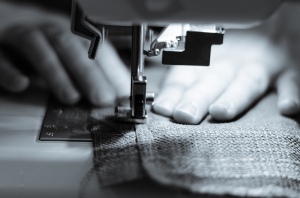I am working on a story about a woman named Rita. I imagine her as a small woman with salt-and-pepper hair, who, on most days, wears a cardigan around her shoulders. She never leaves the house without a little powder on her nose and her favorite light pink lipstick on her lips.
I write a sad scene where Rita sits next to Martin, her dying husband, who is lying in a hospice bed. When I reach this part of the drama, I intently watch Rita in my mind’s eye: She holds Martin’s hand, occasionally stroking his thin fingers, watching him breathe, slower and slower, it seems. Rita wonders which breath will end up being his last.
I know that Martin is going to die, but I don’t know what is going to happen after that. Rita and I wait.
While the death scene lingers, I get up and make a cup of tea, take a Facebook diversion, and see that Christopher Methven has posted a stunning black-and-white photo of hands at work at a sewing machine. The hands, I assume, are the hands of his girlfriend, Pat Langford. I look at this picture for a long time. It is riveting. I show my appreciation by “liking” it.
My break complete and my tea cup empty, I go back to work on my story.
When I return, Rita is still sitting there next to Martin, but she has scooted her chair closer to him so that she can rest her hand more easily on his forearm. She continues to stare at her husband, unable to imagine that there is a new reality patiently standing outside of the hospice room, waiting to accompany her home.
When Martin takes his last breath, his mouth is hanging open, and it suddenly turns into a gaping black hole. Rita realizes that the man with whom she has shared 34 years of her life is no longer a man. He is gone now, replaced by body that looks like Martin, but it’s not really Martin. Rita and I sit there and look at him, unable to leave.
The same way that life changes in an instant, my brain goes to black, a quick cut, and then the story moves to Rita at home, in her brick bungalow. She sits at the window, watching her neighbor shovel snow from her sidewalk. I am not sure if this is the same day that Martin dies, or maybe it’s months later. I know that I have to go back in time and figure that out at some point, but now I am just watching where she goes, what she does. While I watch Rita, quick flashes of Chris’s photograph appear in my mind.
I am surprised when Rita gets up, adjusts her cardigan, and walks into a little room in the back of the house. Ah ha! She has a sewing room, a tidy little cove with striped wallpaper. She sits down at the machine and removes its cover. Although she feels somewhat numb, moving as if she’s in a trance, she methodically arranges her fabric, assesses where she left off, and readies to catch up on the pillow covers she started before her husband’s downward spiral.
Rita aligns the fabric and starts the machine, slowly at first. She presses down firmly on the foot pedal. As soon as the needle punctures the fabric, she flinches, feeling pain stab at her heart. As she ramps up the pressure on the machine, the thump thump thump of the needle gets faster and stronger. With each stitch, Rita accepts the needle’s relentless puncturing. The faster the speed, the more excruciating her pain. But she doesn’t stop, she doesn’t make a sound. She keeps sewing. Her tears drip onto the fabric.
But the image of the photo keeps popping into my imagination, telling me that something is off kilter in this moment with my main character. I am compelled to go back to Facebook and look at the picture again.
The problem is suddenly obvious. The photograph is not at all about pain, especially not about harrowing pain.
There isn’t one bit of distress apparent in this photo, even though those fingertips might get pinched. In one simple, beautiful, and clear image, we see the grace and power of action, intensity, concentration, commitment, and creation.
I realize then that I have to change the story. Rita isn’t pierced with pain when she sews.
When she takes up her project, she finds solace, purpose, perseverance. With each turn of the wheel, she is crafting a new beginning.
